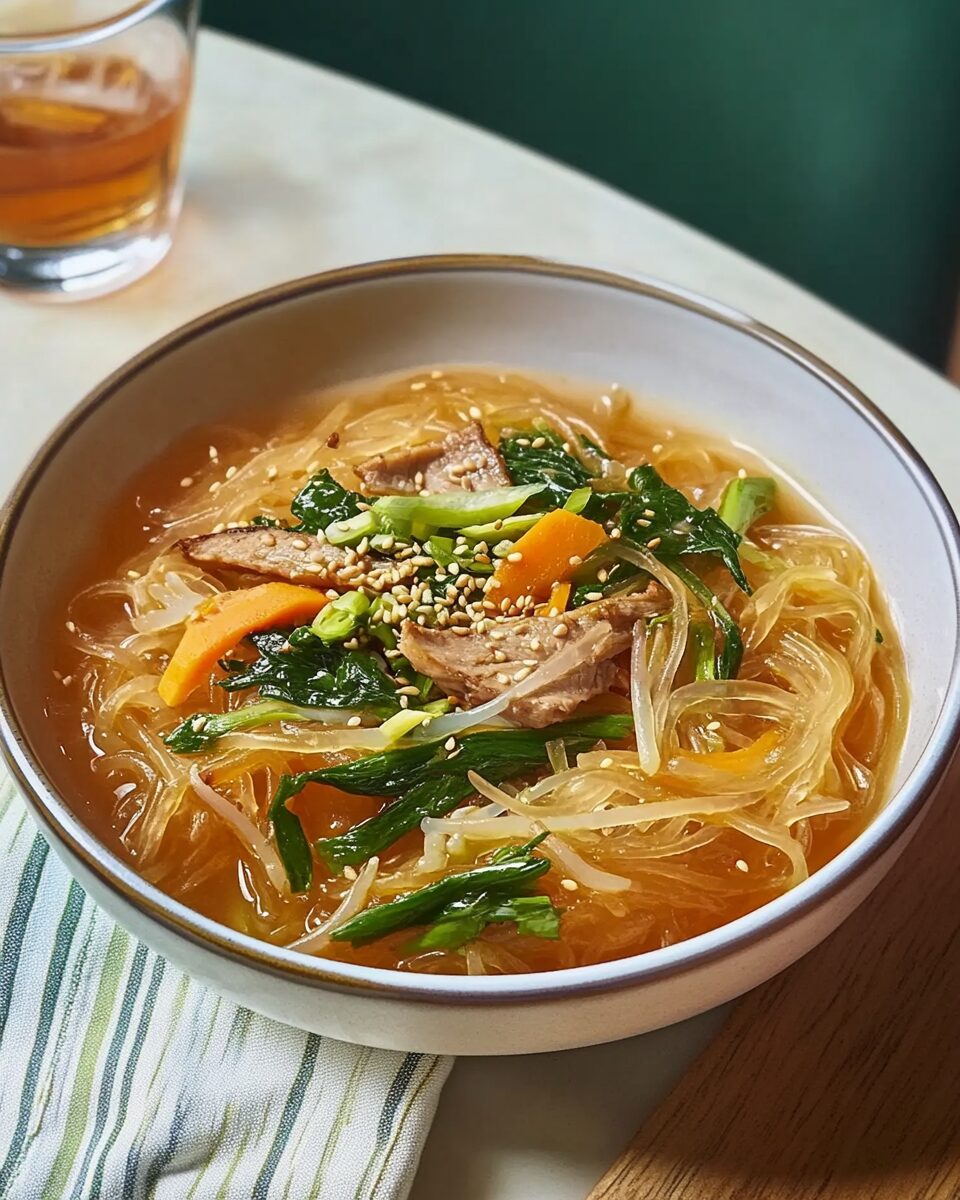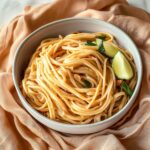Japchae is a popular Korean dish made of stir-fried glass noodles with vegetables, and sometimes meat. It’s a savory, sweet, and healthy meal that’s often served during celebrations or as a side dish. This flavorful dish can be enjoyed as a main or a side, and it’s packed with a variety of textures and colors, making it visually appealing as well as delicious.
Full Recipe:
Ingredients
- 8 ounces sweet potato glass noodles (dangmyeon)
- 2 tablespoons sesame oil
- 1 small onion, thinly sliced
- 2 garlic cloves, minced
- 1 carrot, julienned
- 1 red bell pepper, thinly sliced
- 1/2 cup spinach leaves, chopped
- 1/4 cup shiitake mushrooms, thinly sliced
- 2 tablespoons soy sauce
- 1 tablespoon sugar
- 1 tablespoon sesame seeds
- 1 tablespoon toasted sesame oil
- 1 tablespoon rice vinegar
- 1/4 teaspoon black pepper
- 1/2 pound beef sirloin (optional), thinly sliced
Directions
- Cook the glass noodles according to the package instructions, drain, and set aside.
- Heat sesame oil in a large skillet or wok over medium heat. Add the onion and garlic and sauté until softened, about 2 minutes.
- Add the carrot, bell pepper, and mushrooms to the pan, stir-fry until vegetables are tender, about 5 minutes.
- Add the cooked noodles, spinach, soy sauce, sugar, and sesame seeds to the skillet. Stir everything together until well combined and heated through, about 2 minutes.
- For extra flavor, add the toasted sesame oil, rice vinegar, and black pepper, and stir until the noodles are evenly coated.
- If using beef, cook the beef separately in a pan and add to the noodle mixture just before serving.
- Serve hot, garnished with additional sesame seeds if desired.
Nutrients
- Calories: 210 kcal
- Carbohydrates: 30g
- Protein: 7g
- Fat: 8g
- Fiber: 3g
- Sodium: 250mg
- Sugar: 5g
History and Origins of Japchae
Japchae, also known as chapchae, is deeply rooted in Korean culinary history. The dish dates back to the 17th century during the Joseon Dynasty. It is said that Japchae was originally created as a royal dish for King Gwanghae, who ruled Korea from 1608 to 1623. The story goes that the king was so impressed with the dish’s unique blend of flavors and textures that it became a part of royal banquets.
Over time, Japchae evolved from a dish reserved for royalty to a more accessible food enjoyed by families and communities. It was introduced into everyday Korean cuisine, where it became especially popular for birthdays, celebrations, and other significant gatherings. Today, Japchae is a symbol of Korean culture and is commonly served at both festive and casual meals, loved for its healthful ingredients and delicious taste.
What Makes Japchae Special?
One of the reasons Japchae has become so popular outside of Korea is due to its unique combination of ingredients and flavors. The glass noodles used in Japchae are made from sweet potato starch, which gives them a translucent, slightly chewy texture. Unlike regular pasta, which can sometimes be soft or mushy, these noodles retain their texture even after being stir-fried, providing a satisfying bite with every mouthful.
In addition to the noodles, Japchae includes an array of vegetables, each contributing its own distinct flavor and texture. The onions provide a slight sweetness, while the carrots add a crunchy bite. The spinach adds a mild earthiness, and the bell peppers offer a burst of freshness. Shiitake mushrooms, which are often included, lend a rich, umami flavor that deepens the dish’s overall taste profile.
Another aspect of Japchae’s appeal is its versatility. While the dish traditionally includes beef, chicken, or pork, it can easily be adapted to suit vegetarian or vegan preferences by omitting meat or adding plant-based proteins like tofu. The soy sauce-based seasoning can also be adjusted to suit different taste preferences, with variations incorporating garlic, sesame oil, or rice vinegar to create a balanced, savory-sweet sauce.
Japchae Ingredients and Variations
Japchae’s beauty lies in its flexibility, allowing for variations based on regional preferences or personal taste. The essential components of the dish are the sweet potato glass noodles, vegetables, and soy sauce-based sauce. However, many different ingredients can be added or swapped out, depending on what you have available or what flavors you prefer.
While the classic recipe includes beef, many people prefer to use other meats, such as chicken or pork. In some variations, seafood such as shrimp can be incorporated for a unique twist on the dish. Japchae can also be made with various vegetables, such as zucchini, broccoli, or even bean sprouts, depending on the season and availability. If you’re aiming for a lighter version, you can increase the amount of leafy greens like spinach or add mushrooms to make the dish even more nutritious.
For those following a vegetarian or vegan diet, Japchae can be made without meat and still be flavorful and satisfying. Tofu is often used as a protein substitute, offering a firm texture and ability to absorb the sauce. Additionally, some people use alternative seasonings like tamari for a gluten-free version or coconut aminos for a soy-free option.
Nutritional Benefits of Japchae
Japchae is a nutritious dish that can be enjoyed as part of a balanced diet. The main ingredient, sweet potato starch noodles, is naturally gluten-free and a good source of carbohydrates, making it a filling and energy-boosting dish. Unlike traditional wheat-based pasta, sweet potato noodles have a unique texture and are a healthier option for those who are sensitive to gluten or looking for a lighter pasta alternative.
The vegetables used in Japchae provide a wealth of vitamins, minerals, and antioxidants. Carrots, for example, are rich in beta-carotene, which is essential for eye health and immune function. Bell peppers are packed with vitamin C, an antioxidant that supports the immune system and promotes skin health. Spinach is a great source of iron and folate, which are important for blood health and cell function. Mushrooms add fiber and various minerals, including potassium and magnesium, which are essential for heart health.
Additionally, Japchae is a relatively low-calorie dish when prepared with moderate amounts of oil and sugar. The sesame oil and soy sauce contribute healthy fats and flavor, while the sugar in the recipe helps balance the savory ingredients with a touch of sweetness. For those watching their calorie intake, Japchae can be made even healthier by reducing the sugar and oil content, making it a customizable and balanced meal option.
How to Serve and Enjoy Japchae
Japchae can be served in various ways, making it suitable for different occasions. Traditionally, it is served warm as a side dish to complement other Korean dishes, such as grilled meats or rice. However, Japchae is also a great dish to serve as a main course, particularly when paired with a protein source like chicken, beef, or tofu.
Japchae is often featured at Korean celebrations, such as birthdays, New Year’s Day, or during holidays like Chuseok (Korean harvest festival) and Seollal (Lunar New Year). The dish is also commonly served at family gatherings, where its bright colors and mix of textures make it an attractive and inviting dish to share.
In addition to being served as a main or side dish, Japchae can be packed in bento boxes for lunch, making it a convenient and portable meal option. It is also a great dish for meal prep, as it can be made in advance and enjoyed throughout the week. Japchae can be reheated, but it is best served fresh to preserve the texture of the noodles and vegetables.
Conclusion
Japchae is more than just a delicious Korean dish – it’s a symbol of Korean culture, celebration, and culinary tradition. Whether you enjoy it as a main course or a side dish, Japchae offers a balanced mix of textures, flavors, and nutritional benefits. With its versatility, it can be adapted to suit a variety of dietary preferences, making it a dish that everyone can enjoy.






